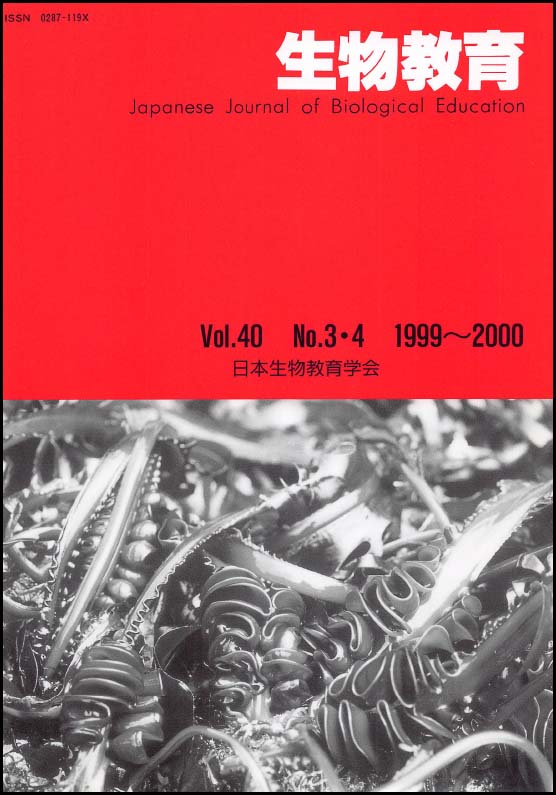
- Issue 3-4 Pages 122-
- Issue 2 Pages 58-
- Issue 1 Pages 2-
- |<
- <
- 1
- >
- >|
-
T. Fukui2000Volume 40Issue 3-4 Pages 122-138
Published: 2000
Released on J-STAGE: October 29, 2021
JOURNAL FREE ACCESSThis study dealt with the investigation of students’ evolutionary concepts after learning the “evolution of life” in high school.
These following results emerged: (1) majority of the students possess evolutionary concepts similar to Lamarckism, (2) some of the students possess old evolutionary concepts which are no longer valid, (3) many students have inadequate understanding of present scientific evolutionary concepts, (4) many students have inadequate understanding the evolutionary theory based on “population genetics”, and (5) students have misunderstanding of “natural selection”.
Although students scored high on some questions, accumulated data suggested a lack of systematic understanding of evolutionary theory.
View full abstractDownload PDF (44805K) -
K. Morimoto, T. Kumatani, Y. Uchiyama2000Volume 40Issue 3-4 Pages 139-144
Published: 2000
Released on J-STAGE: October 29, 2021
JOURNAL FREE ACCESSUltraviolet (UV)-irradiated damage and photoreactivation in Paramecium tetraurelia (stock 51) were examined to introduce these phenomena into laboratory exercises in high school biology.
UV irradiation was carried out by a UV lamp (UV-B). After UV-irradiation at 500 J/m2 and 1,000 J/m2 the Paramecia were grown in the dark at 25°C for 6 days. The number of cells grown was higher with no radiation.
The Paramecium irradiated at 500 J/m2 and 100 J/m2 were exposed to fluorescent light (20,000 lx) for 24 hrs at 25°C, and photoreactivation effects were examined. This post-treatment with fluorescent light reduced the effects of UV radiation, remarkably. This result indicates that the UV-induced lethality was rescued by photoreactivation. However, the number of cells grown was higher with both UV and florescent light radiation.
We propose this experiment as a biology exercise in high schools, since it can be carried out with simple devices and results can be achieved in 6 days.
View full abstractDownload PDF (17308K) -
C. Ohkawa2000Volume 40Issue 3-4 Pages 145-157
Published: 2000
Released on J-STAGE: October 29, 2021
JOURNAL FREE ACCESSThe objective of this study was to improve plant identification functions of the computer program and its underlying database described earlier (Ohkawa 1997). The new database is a “matrix” of 2,172 species of seed plants consisting of 166 characters. A new program was developed for utilizing their characters as synoptical keys for plant identification. It includes plant identification as its main function. The program also includes some supplemental functions related to plant identification, i.e., extraction, addition, correction of plant data and presentation of plant photographs. This program was used in exercises by school teachers and university students. Overall results from the exercises showed that the new program was used effectively for plant identification.
View full abstractDownload PDF (35190K) -
H. Imoh2000Volume 40Issue 3-4 Pages 158-165
Published: 2000
Released on J-STAGE: October 29, 2021
JOURNAL FREE ACCESSA questionnaire survey on high school biology education revealed that university students felt difficulties in the understanding of normal amphibian development and of the significance of fate maps, probably due to a lack of adequate teaching materials. In order to improve these conditions, I drew 3-dimensional fate maps of newt gastrulae and visualized movements of presumptive areas during gastrulation. These figures clearly showed that the presumptive areas of ectodermal organs gradually enlarged to cover the whole surface of the embryo and that those of mesodermal organs moved inside of the embryo to underlie the ectoderm by the end of the neurula stage. Another questionnaire survey suggested that the constructed 3-dimensional figures would work as an effective teaching material. The presented figures were discussed in relation to student’s understanding of the concept of fate maps, presumptive areas and determination.
View full abstractDownload PDF (20984K)
- |<
- <
- 1
- >
- >|